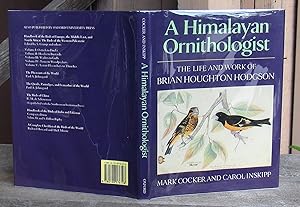 Himalayan Ornithologist (A)
Himalayan Ornithologist (A)

Our present-day knowledge of the birds of the Himalayan region can be traced back to the pioneering work of Brian Houghton Hodgson who was a 19th century naturalist, scholar and administrator. Born in Cheshire in 1800, Hodgson was resident in Kathmandu for many years and he described or collected over 120 species of birds new to science. He trained a team of Nepalese artists to produce water-colour plates of the birds of the Himalayas; this was never completed, but the collection of paintings is now in the possession of the Zoological Society of London. Most of the 49 plates selected for this volume have never been published before. While concentrating primarily upon Hodgson's ornithological work, this book also describes his contributions to other branches of natural history and ethnography, as well as his work on the nature of the Buddhist religion. His administrative career is also outlined and there is a chapter describing the changes to the bird life of the region since Hodgson 's time.
|
|
Bryan Houghton Hodgson (1800-1894)
Born in Cheshire in 1800, Bryan (or Brian) Houghton Hodgson studied at the East India Company’s Haileybury College from 1816 –17 before sailing to Calcutta to take up an administrative position with the Company. Unfortunately he suffered from ill-health and was transferred to Kumaon in the foothills of the western Himalayas to recover. In 1820, he was promoted to the position of Assistant Resident to the Court of Nepal but finding little to do in Kathmandu, he returned to the bustle of Calcutta. There he was again taken ill, and moved back to Kathmandu, becoming acting Resident and finally Resident of Nepal in 1829 and 1833 respectively. After 23 years of service in Nepal, Hodgson resigned in 1843. Following a short sojourn in England he returned to India in 1844 and lived in Darjeeling, a town close to the Nepalese border, until 1858 when he returned to England.
Hodgson’s role as Resident of Nepal was not a demanding one and so he had plenty of time and the financial resources to undertake a thorough study of the natural history of Nepal. He became fascinated with the culture of Nepal, Himalayan Buddhism, architecture, ethnography and linguistics. He is also considered responsible for the introduction of the Gurkhas into the British Indian Army.
Hodgson had a special interest in the birds and mammals of Nepal and the surrounding Himalayan region. He discovered many new species and wrote more than 140 scientific papers. Hodgson’s zoological papers are particularly interesting as he described the animals’ habits and habitat in great detail. As he was unable to travel freely around Nepal he relied heavily on the knowledge of local people to provide him with these observations. He also kept a number of wild animals in captivity. Hodgson made vast collections of specimens; over 10,500 specimens were donated to the British Museum.
The Hodgson Drawings Collection
Hodgson commissioned thousands of drawings of birds and mammals from Nepalese artists. These artists were trained by Hodgson to paint in the style required for scientific illustration. The drawings accurately depict the natural colours and external anatomy required for scientific identification. Hodgson frequently dissected his specimens to show the skeletal and other anatomical features and encouraged artists to sketch these extra details on the drawings. He would also frequently add his own detailed comments on the side. Unusually, the names of some of Hodgson’s Nepalese artists are known. Rajman Singh was a Nepalese draughtsman who worked for Hodgson for many years. Some of his drawings were published in articles written by Hodgson in the Calcutta Journal of Natural History and Asiatic Researches . There is one signed bird painting by him in the collection. Another artist who worked for Hodgson was Tursmoney Chitterkar of Nepal, currently nothing is known about his life.
Hodgson intended to publish a lavish book on the mammals and birds of Nepal illustrated with hand-coloured plates. As part of this project he arranged for his collection of drawings to be duplicated to produce a set suitable for reproduction. Despite Hodgson’s strenuous efforts, the book was never published. A deeply disappointed man, Hodgson disposed of his drawings and specimens to several institutions in England including the British Museum. In recognition of the size and importance of Hodgson’s collections the Keeper of Zoology at the British Museum, J. E. Gray published catalogues of Hodgson’s collections in 1846 and 1863. The British Museum was also the recipient of over 1,400 paintings of birds, mammals, reptiles and fish. These were later transferred to the Natural History Museum. |